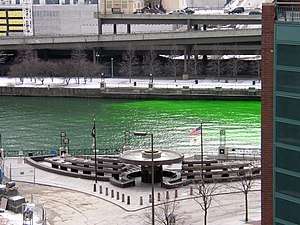Dye tracing
Dye tracing is tracking and tracing various flows using dye added to the liquid in question. That is, it uses dye as a flow tracer. The purpose of tracking may be an analysis of the flow itself, of the transport of something by the flow of the objects that convey the flow. It is an evolution of the ages-known float tracing method, which basically consists of throwing a buoyant object into a waterflow to see where it goes or where it emerges.
Dye tracking may be either qualitative, i.e., the presence of particular flow and its estimate, or quantitative, when the amount of the traced dye is measured by special instruments.
Fluorescent dyes

Often fluorescent dyes are used for this purpose, especially in the following circumstances
- Insufficient lighting (e.g., sewers or cave waters)
- Precise quantitative data are required, measured by a fluorometer
- Very small amounts of the dye is allowed to be added (1 part per trillion may be detected).
Fluorescein is among the first fluorescent dyes, developed in 1871. Its disodium salt under the trademark "Uranine" was developed several years later and still remains among the best tracer dyes.[1]
Other popular tracer dyes are rhodamine, pyranine and sulforhodamine.
Quantitative tracing
Carbon sampling was the first method of technology-assisted dye tracing that was based on the absorption of dye in charcoal. Charcoal packets may be placed along the expected route of the flow, later the collected dye may be chemically extracted and its amount subjectively evaluated.
Filter fluorometers were the first devices that could detect dye concentrations beyond human eye sensitivity.
Spectrofluorometers developed in the mid-1980s made it possible to perform advanced analysis of fluorescence.
Filter fluorometers and spectrofluorometers identify the intensity of fluorscence that is present in a liquid sample. Different dyes and chemicals produce a distinctive wavelength that is determined during analysis.
Tracing methods
Water flows, differentiated by the environment, possess certain factors that can affects how a dye performs. Natural fluorescence in a water flow can interfere with certain dyes. Presence of organics, other chemicals, and sunlight can influence the intensity of dyes. Each sampling area is analyzed by a quantitative instrument to test the background fluorescence.
Each dye has significant performance factors that distinguish it in different settings. These factors influence how each dye interacts and is affected by each environment. Therefore, one dye can be particularly useful in one environment, whereas it could be inadequate another. These performance factors include:
- Resistance to absorption
- Surface water loss
- Limitations of use in acidic waters
Applications
Water tracing
Typical application of water flow tracing include:[2]
- Plumbing/piping tracing
- Leak detection
- Checking for illegal tapping
- Pollution studies
- Natural waterflow analysis (rivers, lakes, ocean currents, cave waterflows, karst studies, groundwater filtration, etc.)
- Sewer and stormwater drainage analysis
Medicine and biology
Dye tracing may be used for the analysis of blood circulation within various parts of the human or animal body. For example, fluorescent angiography, a technique of analysis of circulation in retina is used for diagnosing various eye diseases.
With modern fluorometers, capable of tracking single fluorescent molecules, it is possible to track migrations of single cells tagged by a fluorescent molecule (see fluorescein in biological research). For example, the fluorescent-activated cell sorting in flow cytometry makes it possible to sort out the cells with attached fluorescent molecules from a flow.
See also
- Fluorescence microscope
- FLEX mission
- Fluorescent green pig
- Float tracking
References
- ↑ An educational website about karst and dye tracing, by Crawford Hydrology Laboratory / Center for Cave and Karst Study in association with Western Kentucky University
- ↑ Water Tracing Dye Technical Bulletin Archived 2007-02-03 at the Wayback Machine.